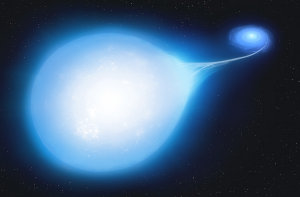Supernovae type Ia are very important standard candles for distances in the universe, as they are very bright. Since the mechanism will produce an explosion of a certain luminosity the brightness of the event observed from earth will immediately give a glimpse at the distance of the supernova. In order to understand these processes in the universe it is crucial to know which systems can end in a supernova of this type. In order to explain the type Ia two scenarios can be used, both requiring at least a binary system. In all cases a white dwarf, the end-state of a low mass star, will somehow exceed the so called Chandrasekhar limit of 1.4 solar masses and as a result of that a thermonuclear explosion is triggered. The first mechanism is that a white dwarf accretes matter from its companion star, hence at some point exceeding the mass limit. Another option, however, is the merger of a white dwarf and a compact companion star. Finding progenitors of such systems is crucial to understand under which circumstances these supernovae occur. Nevertheless, it is very hard to find such systems, with only a few known so far.
Prof. Dr. Ulrich Heber, Dr. Andreas Irrgang, and PhD-student David Schneider from the Remeis observatory are part of an international team of scientists who found a new progenitor system located 1,500 lightyears away from earth. The binary system HD 265435 consists of a hot subdwarf star, a stripped helium core burning star, and a white dwarf. The stars were analyzed using spectra, which were also taken with the ESI spectrograph at Keck observatory, light curves from TESS, and astrometric data from the Gaia space mission. The results show that the binary system consist of a pulsating subdwarf OB star and a white dwarf with a carbon-oxygen core which orbit each other with a period shorter than 100 minuets. Due to gravity of the white dwarf the subdwarf star is distorted and has a teardrop-like form (see image). The entire system has a mass of about 1.65 solar masses, therefore, exceeding the Chandrasekhar mass.

Artist’s impression of the HD265435 system at around 30 million years from now, with the smaller white dwarf distorting the hot subdwarf into a distinct ‘teardrop’ shape. Credit: University of Warwick/Mark Garlick
Simulations show that both components of the system will form a supernova type Ia in approximately 70 Million years. Most likely the subdwarf will become a white dwarf itself in the future. While orbiting each other the orbit will get tighter due to radiation of gravitational waves. Finally both white dwarfs will merge, resulting in a supernova of type Ia. However, depending on the properties of the subdwarf, it could also be possible that the white dwarf accretes enough mass from its companion before a merging event. Therefore, both proposed scenarios for type Ia supernovae could occur in the system HD 265435.
Such systems are very rare. Actually, even with this new discovery too few systems are known in our Galaxy to explain the observed rate of occurance of Ia supernovae in other galaxies. Future missions such as the Vera Rubin telescope will have to find the hidden population of supernova Ia progenitors.
Further information:
- FAU press release
- University of Warwick press release
- Keck press release
- Publication in Nature Astronomy
For more information contact:
Ulrich Heber
Ulrich.Heber@sternwarte.uni-erlangen.de
+49 951 95222 14
Andreas Irrgang
Andreas.Irrgang@sternwarte.uni-erlangen.de
+49 951 95222 16





